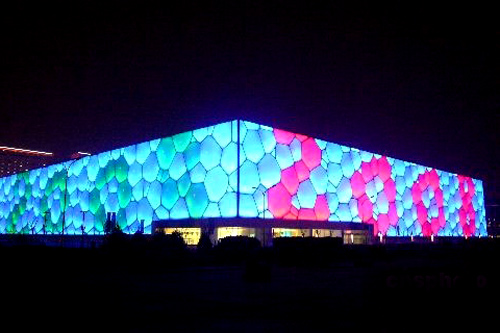The National Aquatic Center, known as the Water Cube, is one of the most dramatic and exciting venues to feature sport events for the 2008 Beijing Olympics.

Resembling a gigantic blue box of bubble-wrap, the Water Cube looks iridescent, elegant and magical.
Located in the Beijing Olympic Green, it covers an area of nearly 80,000 square meters and stands alongside the National Stadium, nicknamed the Bird's Nest, the two iconic structures for the Beijing Olympics.
But compared to the elliptic steel-framed stadium, the rectangular Water Cube appears lighter and tender, and presents a beautifully sharp visual contrast.
Designed by a joint Chinese-Australian consortium, it is inspired by the natural formation of soap bubbles to give a random, organic appearance.
In July 2003, the consortium of Arup, architecture firm PTW, the CSCEC (China State Construction and Engineering Corporation) and the CSCEC Shenzhen Design Institute won the international design competition for the National Aquatics Centre for the 2008 Beijing Olympics.
Work on the Water Cube began at the end of 2003 and four years later, a wonder was finally created and made its debut in January 2008 in the spotlight of the whole world.
With a seating capacity of 17,000, the center will host the swimming, diving, synchronized swimming and water polo events during the 2008 Olympics.
After the Aug. 8-24 Games, the Water Cube will be refurbished into a multi-functional recreation center, providing various aquatic facilities for both citizens and athletes.
In daylight, the Water Cube shines as a blue translucent spectacle; while at night, it offers spectators a glowing crystal palace with LED-lit bubbles.
"This is an excellent and wonderful facility...and the best aquatic venue by far," said Richard Kevan Gosper, media commission chief of the International Olympic Committee (IOC).
Adopting an ETFE pneumatic die cushion structure, the Water Cube is the world's largest membrane structure building.
Eye-catching as it is, the Water Cube is environment-friendly too.
The 100,000 square meters of the Teflon-like translucent plastic ETFE that make up the building's bubble cladding allow in more solar heat than glass, making it easier to heat the building, which cuts energy costs by up to 30 percent. That's especially important for a swimming pool, which requires an enormous amount of heating.
Besides the solar energy, all backwash water of the center is filtered and returned to the swimming pools.
With an unearthly design, concise and pure appearance, as well as use of eco-friendly technology, the Water Cube is definitely a classic of architecture in the Olympic history.
(Xinhua News Agency June 4, 2008)